A Newbie Gets Faster at Porsche Track Experience Driving School

All I wanted to do was to learn how to drive faster. I was raised by a fearless man, one who spent his youth driving in illegal road rallies on the narrow, twisty roads of Ireland in Minis. The same man who would regularly scare my friends as he drove us to the movies or the bowling alley or the roller rink with his seeming lack of recognition of how fast he was driving or how hard he was braking. As an adult and as a car writer, I considered myself a good driver but a bit too cautious, especially given my roots.
So I set a goal to get faster and began talking about it to whoever would listen. And that landed me an amazing opportunity: to go through three levels of the Porsche Track Experience driving school at Barber Motorsports just outside Birmingham, Alabama. And the timing ended up being fairly sentimental for me: I went last July, almost 25 years to the day since my dad had passed away.
All I wanted to do was learn how to drive faster, but I came away with a lot more. Confidence in myself and in my ability to drive, a reminder that getting better at things takes time, and a renewed appreciation for doing things for yourself that are fun. The Porsche Track Experience was easily the best thing I did for myself during Covid, and maybe the best thing I’ve done in a decade.
Andi HedrickCar and Driver
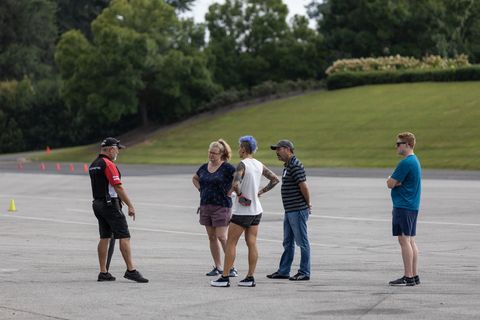
Andi HedrickCar and Driver
Day One: Performance Course
Porsche has driving schools scattered across the globe, and it may seem like hosting one in Birmingham is a little off the beaten path. But Barber Motorsports is one of the most immaculate, landscaped, and well-maintained courses I’ve been to. The Performance Course here is one of Porsche’s most popular driving classes, despite its price tag of $3600 for two days. It is already sold out for 2022, although Porsche does maintain a waiting list in case there are dropouts.
The day starts with one hour of classroom instruction, in which we are encouraged to imagine our steering wheel is attached by a string to the gas pedal or brake. If the steering wheel is straight, you can hit the gas or brake as hard as possible, because there is enough room in the string to handle those inputs. But if you’re turning in either direction, the string will be tauter, so you need to use less braking or acceleration. It’s a great visual way to think about driving dynamics and the limits of what tires can handle on the road, and it’s not a concept the Porsche Driving School made up on its own. Still, it’s useful. We’re also encouraged to keep our eyes up and look toward the next turn, and to learn the driving lines as best we can.
My group starts in the parking lot to do some dynamic exercises while other groups hit the track. We hit the skidpad, which I am confident I’ll ace because of my years driving in the snow in Michigan. It is more frustrating than I expected. We also do a short cone course in which we are encouraged to speed up as fast as possible and then hit the brakes as hard as possible when we reach a certain set of cones. This exercise is an eye opener for me; I realize I’ve never used brakes to their full capacity before, and I could drive so much more confidently on public roads if I made sure to test the full capacity of my brakes. We also do a short autocross course, which is fun, and I’m surprisingly one of the fastest in our group.
When we eventually make it out to the 2.4-mile racetrack in the 911 Carrera S, I’m pleased to see they’ve set it up kind of like bowling alley bumper lanes. They’ve laid out cones around each of the 16 turns to show us the correct driving line. We don’t have to give much thought to where the braking points are, where to turn, and where to aim when coming out of a turn. Which is good, because there are so many other inputs to deal with. Learning to drive in a pack with five strangers is overwhelming. Keeping your eyes up while somehow also spotting the cones at the same time is work. Remembering where to keep your hands, and trying to feel for understeer or oversteer (and reminding yourself which one is which). Straining to hear the instructor as they stare in their rearview mirror while driving around the track and critique each student behind them. That last one is distracting because it is such an impressive feat. It’s like the old line about Ginger Rogers being a better dancer than Fred Astaire because she did everything he did but backward and in high heels. These instructors are like Ginger Rogers, except they’re doing everything at 125 mph while staring in a rearview mirror.
By the end of the day, I am exhausted. I fall asleep immediately after getting back to my hotel room and almost miss dinner.
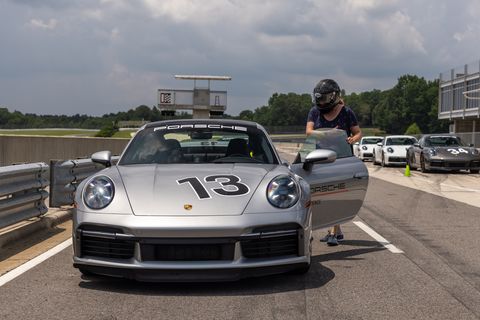
Andi HedrickCar and Driver
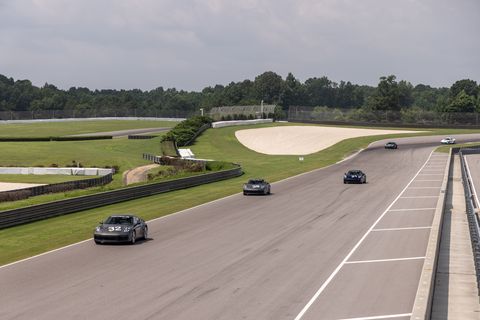
Andi HedrickCar and Driver
Day Two: Performance Course
The next morning, my whole body hurts. My jaw, my shoulders, even my forearms. I am obviously way too tense. We have a second day of more of the same—some skidpad time, some braking exercises, and an official timed autocross race pitting our group against the others. (My team loses; we hit too many cones.) Our last session of the afternoon on the track is hard. The entire group has sped up quite a bit from the day before, and we’re going so fast that it’s easy to fall behind with one or two imprecise turns or braking spots. But I feel like I’m improving. And I remember to breathe and relax my arms and shoulders most of the time.
In the early afternoon, we get ferried around the track as the instructors drive us to show us how it’s really done. I realize I’ve been way too gentle on the brakes, even though I feel like I’m hitting them hard, and could be much more aggressive heading into braking zones.
Day Three: Masters Course
The two-day Masters Course often runs immediately after the two-day Performance Course, but it costs considerably more, coming in at $5200. A whole new set of faces show up for the Masters Course. This group is clearly more serious than the last batch of students. The shuttle from our hotel to the racetrack is quieter, and more people have brought their own helmets. We start again with an hour of classroom instruction. In this class, we go over the steering wheel string theory again, plus understeer, oversteer, and proper speed into turn entries and exits. We also go over flags and how to interpret them, because this time we won’t just be following our instructors around the course. At some point, we are going to be allowed to drive on our own. I get a little sweaty thinking about this—I like the security of the lead/follow thing we’ve been doing.
We do more braking exercises in the parking lot, controlled spinouts on the skidpad, and a few autocross laps. Then we head back out to the track and do a session of lead/follow. There are fewer cones on the course, so we’re forced to start visualizing our own racing line, but the apex points and brake points are still marked with cones.
By the afternoon, we are set free to lap on our own. The instructors all get shuttled out to various spots on the track and take detailed notes as we speed by. I decide I’m going to try to focus on hitting the correct line and not worry too much about going fast. Later, when I’ve been passed nine or more times in one session, I have to remind my ego that that was the plan all along. In-car video from the drives no doubt shows me cursing every time I get passed, but I’m otherwise focused.
The best part turns out to be the feedback from the instructors. At the end of each session, they arrive back at the pit, and everyone jockeys to meet up with each instructor, who then tells you how well you did each individual turn. I am driving past cones that mark when to turn at corners 9 and 12, and coming into corner 4 way too slow.
I’m eager to get back out on the track and use that feedback to improve, but a series of thunderstorms roll in and we revert to lead/follow for the rest of the afternoon to ensure none of us spin out or hurt ourselves or the cars.
Day Four: Masters Course
The second day of the Masters course is a lot like the first: tons and tons of track time, plus more dynamic exercises in the parking lot. We also do a timed autocross, which I would have won had I not blown through four million cones at one end of the track.
I get a lot of good feedback after our last set of runs, I even got a check-plus on one turn. My last critique included the words “moments of brilliance,” which was praise for my efforts to actually find the turn-in point on corner 15, which is kind of in the middle of the track and hard to spot. There’s a part of me that thinks that praise was just ego-stroking, but then my ego takes over and proceeds to crow about the words “moments of brilliance” to anyone who will listen.
Still, I got passed no less than seven times in the last session. “Some people out there are really slow,” one of my classmates tells me. “I think I passed the same person five times.” Yeah, that was probably me.
We spend the last hour of the day shuttling around the outside of the track to watch the other cohort drive around the track, just to get the perspective of our instructors. I fly home after four straight days of classes, tired but exhilarated.
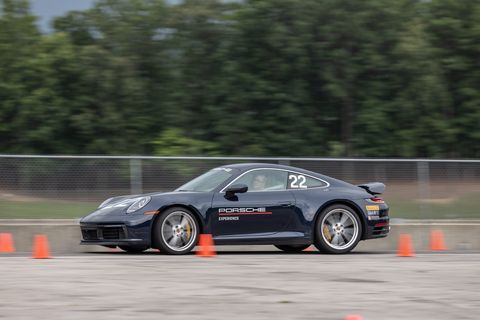
Andi HedrickCar and Driver
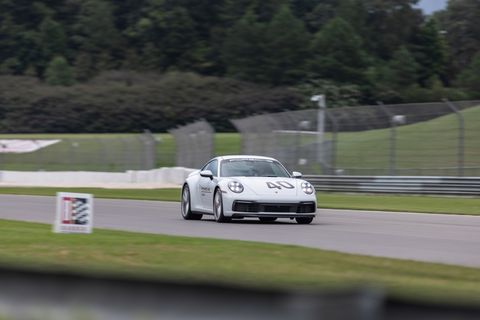
Andi HedrickCar and Driver
Day Five: Masters RS Course
A week and a half later, I fly back to Birmingham to complete the series of classes with the Masters RS course. You can’t get into this class without prior approval or without having attended the other two Porsche classes, and it costs $8700 for the three days of competitive-style driving. This class feels like it’s full of the wealthiest people so far. There are a couple of business owners, one guy who built an artificial intelligence algorithm and sold it, and another person who, when asked what he does for a living, just said, “Retinas.” During my break away from the track, I purchased a book that promises to make me faster: Ultimate Speed Secrets by Ross Bentley. One thing from that book that strikes me is Bentley’s discussion of exit speeds, and how most people don’t focus on getting back up to speed quickly enough.
The instructors announce one thing before we leave the classroom for the day: The Masters RS course is a pass/fail course. Not everyone will get a certificate, and if you get too many black flags you will be pulled from the class.
When we get out to the track, I realize they’ve taken away most of our training wheels. There are only braking cones left on the track. I decide to pick one thing to focus on for each track session. First was driving line, then braking points, and then finally I take on exit speeds. I feel like I’m beginning to know the track pretty well, and I can feel that confidence turning into speed.
I only get passed once all day. And towards the end of the day, the unthinkable happens: I pass someone. I am delighted and want to get out and do it again, but the weather has other ideas. We get rained out for our last session.
Day Six: Masters RS Course
We get five sessions on the track instead of four due to the rain situation the day before. Each session lasts between 25 and 30 minutes, and before I started these classes I wouldn’t have expected each one to be as exhausting as they are. It takes a lot of mental energy to stay focused at high speeds for that long.
As we get out onto the course for round 1, I realize something: All of the cones are gone. I have a moment of panic, but it’s just a fleeting feeling because quickly I realize that the lack of cones is a blessing. My eyes pop up, no longer looking ahead to the ground trying to find the next cone, but instead looking down the track to the next turn-in point. It is much easier to have active head and eye movements with the cones gone.
One area of the track that I am doing OK on is the corkscrew, corners 7, 8, and 9. But immediately after that, I fall apart, which is odd because the track from corner 9 all the way to 12 is straight-ish. But there is some tilt to the roadway that makes the car feel unstable in spots, and I can feel the back of the car get light and squirrelly in a couple of spots, so I’m slowing down a bit too much to compensate. I make a mental note to work on that area and be more aggressive. That backfires. I almost lose control entirely coming out of 11, but my time on the skidpad kicks in muscle memory and I save the car from spinning. Later, the instructor watching corner 11 notes my nice save, but points out that I am not hugging the turn at 11 closely enough and need to not overreact when the car feels light.
After we’re done tracking, we head into the race control building and take a look at the data Porsche tracked for us during our drives. The biggest takeaway for me is that I still need to do a lot of work on exit speeds.
Day Seven: Masters RS Course
We spend the morning lapping again, and I get what turns out will be my best time for the day: 1:47. It is a hot day, and as noon approaches our tires get softer and slow us down. But today is the day for passing. I get passed zero times, and I pass three other people. It feels good. I am glad my classmates can’t hear me crowing as I speed by them.
We go back into the race control building to look at more data, but we all kind of agree that we’re not going to be able to get much better given how hot the track is. That’s OK by me because I feel like I’ve learned a lot already and it gives me time to start stressing about the afternoon session, in which we’ll be learning race starts and earning our certificates. Our group goes second, so we watch the other cohort do their race starts. It seems easy, from the pit. But once we get out there and are side-by-side on the track, I get a little sweaty. I struggle to hear the instructions we’re getting from over the walkie-talkies and find myself completely out of place. It takes just a second to correct, and then we’re off. We do three more starts on the track straightaways, and then we’re done.
I go home with three Porsche Driving Experience certificates to my name and the ability to apply for my novice racing license with the Sports Car Club of America. Did I get faster? Well, I set a base time at Car and Driver’s 2020 Lightning Lap event of 4:06. When I went back to Virginia a few months later, I was able to shave that time down to 3:15. So yes, I got faster. Now I can scare my kids’ friends as we drive to the mall or the bowling alley or roller rink, and if they dare to complain I’ll tell them speed is in our DNA.
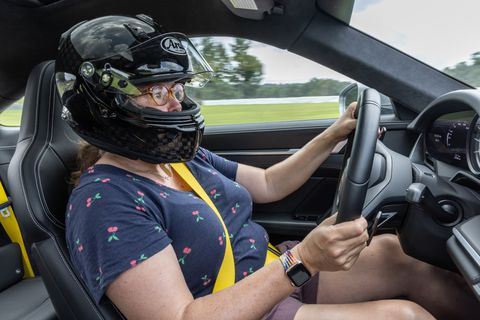
Andi HedrickCar and Driver
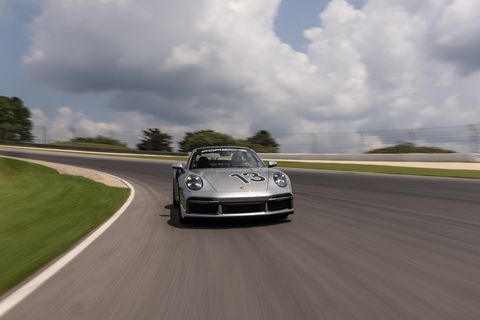
Andi HedrickCar and Driver
This content is created and maintained by a third party, and imported onto this page to help users provide their email addresses. You may be able to find more information about this and similar content at piano.io



